1 How big screen do you need?
It can be said that the original intention of most people who want to own a home theater is that they are not satisfied with the screen and the horn sound of a few dozen inches of TV. They want to enjoy the audio-visual experience close to the cinema at home, so first of all, a large size The curtain is a must, but the bigger the screen, the better. Under the premise that your living room/audio room is placed, what kind of screen is suitable?
According to GB/T 21048-2007 "Classification and Evaluation of Cinema Star Ratings", the standard of five-star cinemas (of course we use the highest standards), of which 6.5.2.4 and 6.5.2.5, "the closest line of sight should not be less than The maximum effective projection screen width is 0.6 times", "the farthest viewing distance should not be greater than 1.8 times the maximum effective projection screen width". Converted, that is: 0.55 * line of sight <= screen width <=1.66 * line of sight, this is equivalent to the feeling of your first row and last row in the cinema.
Generally, the horizontal angle of view of a person's monocular is up to 156 degrees, and the comfort angle of a single eye is 60 degrees. This means that only the objects within the 60-degree range of this single eye can be seen clearly, and the human eye can focus. The peripheral portion that exceeds the horizontal angle of view by 30 degrees is called the induced field of view. The residual light, commonly known as the eye, is actually a range that is not sensitive to the human eye, that is, it cannot be seen clearly. Here we take a comfortable viewing angle of 60 degrees. Assuming our viewing distance is x, then tan(30°)=0.5773=(screen width/2)/x => screen width=1.15*x.
That is, the screen width = line of sight * 1.15 is most suitable, which is basically equivalent to the position in the middle of the cinema. Currently, the screens on the market are mainly 4:3 and 16:9 (the rest of the screen can be customized separately). Generally, for home use, we will choose a 16:9 screen. Below is the size specification of a brand 16:9 screen ( Other brands are basically the same)
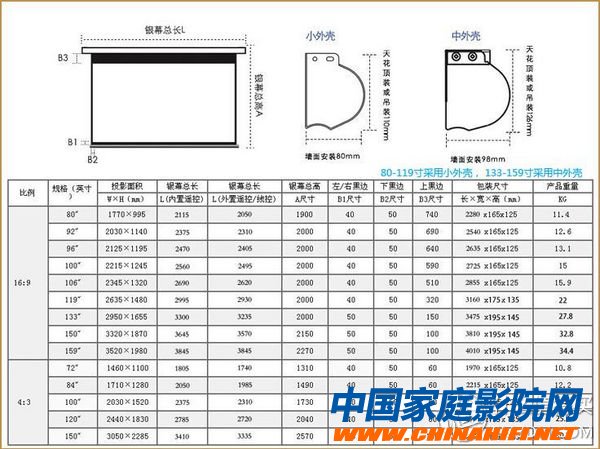
Curtain size
2 curtain selection
2.1 Curtain gain
Gain: A numerical representation of the inherent reflection characteristics of the curtain (the brightness of each angle). A certain amount of light is projected onto the completely diffuse scattering surface (i.e., the reflecting surface having the same reflectance in the 180 degrees above and below the left and right directions), and the reflection brightness at this time is set to 1. Then, under the same conditions, the same light is projected in the direction perpendicular to the screen, and the brightness of the center point and each point on the same arc is measured. The ratio of the brightness to the brightness of the full diffuse scattering is called the gain of the screen.
The effect of screen gain on the image: The image without the gain is flat and faithful, but is susceptible to ambient and external light. The screen with gain brings bright, rich, colorful images with less impact on the environment and external light. However, the gain of the screen and the viewing angle of the screen have a special inverse relationship, that is, the higher the gain, the smaller the viewing angle. If the gain is too high (semi-gain angle is too small), the effect will be bright in the middle of the picture, the effect of the four corners and the high-brightness part will be saturated without layering. Because the energy is too concentrated, only one or two seats in the horizontal direction can be seen. Bright picture. Therefore, depending on the application, the projection screen should be properly selected. The higher the screen, the better the gain.
2.2 The form of the curtain
In terms of installation method, the curtain is mainly divided into a hanging screen, a bracket screen, a folding screen and a ground curtain. At present, the screens for household use are mainly hanging, and the commonly used frame screens and electric screens and electric cable screens (the following brands are reference examples)
Picture frame

The curtain is fixed to the wall like a painting. Use an aluminum frame to make a frame similar to a frame, and then buckle the spring on the curtain to flatten the curtain. This is the simplest type of screen setup, all you need to do is fix it to the wall. The advantage is flatness, the disadvantage is that it can not be collected, it is easy to be polluted by dust, and it is easy to oxidize and discolor when exposed to air for a long time. This is also the biggest drawback of this type of screen, because the position cannot be changed once installed. One advantage of a fixed installation projection screen is that it is usually not easy to wrinkle, which maintains a smooth, flat projection surface. This kind of curtain is suitable for a family with a dedicated audio-visual room, which usually does not need to close the curtain.
Electric screen
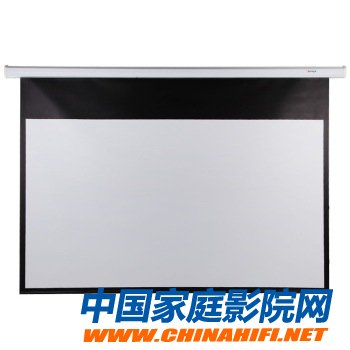
XINGE 120 inch electric projection screen 16:9 white plastic screen electric screen has the advantages of good flatness and easy maintenance. The screen is evenly lowered from the two ends of the motor to ensure that the screen is not affected by external forces. It has easy lifting and easy installation. specialty.
Electric cable screen
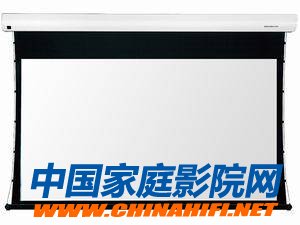
GRADNVIEW Meishi large flat series electric cable gray screen 16:9 106 inch
Part of the electric screen is an electric pull screen. This kind of curtain is the most expensive in the household class. It adds a tension line on both sides of the electric screen to level the screen, while the upper and lower sides add strength by the heavy bottom edge. The advantage of it is of course the leveling (the pulling of the screen is very important, it requires a lot of tension), and it can be put away, and the structure of the whole curtain is very strong and very textured.
Generally, the picture frame is no problem to 200 inches. The electric screen is 120 inches or less. If it is too large, it is not easy to keep it flat. If it needs more than 130 inches and does not have the installation conditions of the picture frame, it is recommended to use the electric cable screen. .
2.3 The material of the curtain
At present, the curtains on the market are mainly divided into five categories: soft curtains, glass curtains, white plastic curtains, glass bead curtains and metal curtains.
Soft screen: The soft screen can only be used for the picture frame, with the best picture quality, the three-dimensional feeling is very rich, and the picture quality is transparent.
Glass fiber curtain: The fabric is woven from glass thread, and the surface layer is coated with PVC material with special projection effect. Thanks to the support of the fiberglass backing, there is no need to level and the natural stretch will be straight.
White plastic screen: The base fabric woven from the textile thread, the surface layer is coated with PVC material with special projection effect, which is slightly inferior to the glass fiber.
Glass bead curtain and metal screen: not much used, characterized by high gain, mainly used for 3D home theater projectors with high light requirements, but high gain will bring a large loss of viewing angle range.
In addition, there are relatively small sound-transparent screens, which belong to the 壕+ audiophile enthusiast level. For this, I just want to say: Hey, friend?
For the average family, white plastic and white glass fiber are good choices. Because the gain of the white plastic screen is 1.0, it will not be limited by the narrow visual range. In addition, the white plastic screen itself has accurate color reproduction capability, which can fully reflect the performance of the projector itself and will not change the color balance. Will not affect the black and white transition. Compared with white plastic, glass fiber should not wrinkle, and the gain is slightly higher than white plastic.
2.4 White screen or gray screen?
The above screens can be made into white screens and gray screens. In simple terms, the white screens are brightly colored, and the gray screens are black and the contrast is good. There are a lot of slobbers on the selection forum for white screens and gray screens. If the shading conditions are not good, or the black level of the projector itself is normal, the gray screen is a good choice. The gray screen was originally created to increase the contrast of the projector, and also has a certain ambient light suppression capability. However, the biggest problem with the gray screen is that it has a certain degree of color dyeing. The color of the projector can usually be recalibrated to obtain the desired color effect. However, the color correction requires special equipment and rich experience, which is troublesome. I personally think that the general family can choose white screen, audio and video enthusiasts can consider the gray screen. (This welcome discussion)
2.5 I don't tell Ta.
It may be a bit of an eye-opener. There are so many kinds of materials and brands of curtains. What are you going to choose? It is better to be able to compare AB with your eyes. So, here is a little experience. If you are optimistic about a brand curtain, you can contact the manufacturer directly, let the manufacturer send you a sample (may need to pay for the postage), and then put a few samples of the manufacturer on the wall, um, so the effect is clear at a glance.
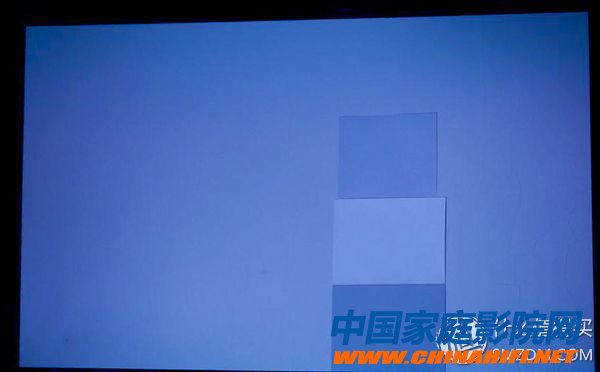
2.6 Issues requiring special attention: installation height
The ideal screen installation height is such that the center position of the effective screen of the screen and the viewer's eyes are at a position slightly higher than the same horizontal line. In order to reduce the cost, some screen manufacturers make the black part at the top of the screen extremely short when the screen is produced. When the screen is installed, the upper floor is used, and the short black side makes the picture too high. The user has to look up the picture at a large angle, which affects the comfort of viewing, and long-term look up also hinders health. Therefore, the installation position of the curtain can be determined according to the situation of the home, and the merchant can lengthen the black part above when buying the curtain.
2.7 Effect of screen size on projection
Generally, the larger the curtain, the higher the brightness requirement of the projector. According to experience, the size of the home screen should not exceed 150 inches (16:9). First, the size of the screen is too large to cause deformation of the screen, and second, the brightness of the projector is not enough. . Projecting a large-size image will cause the brightness to drop and it is not clear enough. Third, the general family has a limited pitch. In order to have a large size, a short focus machine or an ultra short focus machine must be used and the lens is at the wide angle end. At this time, the dispersion and distortion of the lens are larger than that of the medium focus machine. The fourth is too big to really put it down. The total height of the 150-inch screen is close to 2.15 meters (not on the premise of the black side), and the TV cabinet should be placed below. The height of the floor is 2.7 meters, which is reserved for the height of the TV cabinet. Only 55cm left.
3 specific parameter calculation
For example, this is a picture of my living room.

The calculation of the viewing distance is shown in the figure, taking into account the distance from the front to the front and the distance from the projection to the wall.
As shown in the figure: my viewing distance is about 3.9 meters. According to the calculation of the first part above, my curtain width should be 2.145 meters to 6.474 meters, and the optimal width is 4.485 meters, but considering the actual installation, I can only Choose a 119-inch electric fiberglass curtain with a width of about 2.6 meters. There are four reasons:
1. Speakers and air conditioners should be placed on both sides of the curtain.
2, because you have to take into account the projection and TV, you can not frame the screen
3, more than 120 inches of curtains, logistics and transportation difficulties
4, more than 130 inches, the best pull-up screen, or easy to wrinkle
Once you have determined the size of the curtain, you need to determine the black edge height of the top edge of the curtain. Considering that the curtain was lowered to a minimum, there was a TV cabinet below, and I made the seller lengthen by 10cm. Therefore, the upper black side in the figure below = original length 32cm + length 10cm = 42cm.
(Small knowledge: Generally, the electric screen can adjust the upper limit and the lower limit, which can be adjusted by the potentiometer on the screen, that is, the upper black edge in the adjustment map. Of course, the premise is to lengthen a good tone, but do not adjust too much. Otherwise, the curtain will fall and it will not be loaded back.)
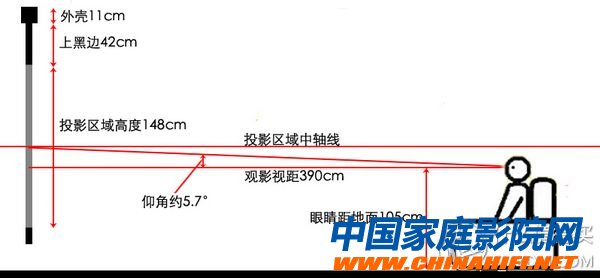
In the figure, "the outer casing is 11cm, the upper black side is 42cm, and the projection area is 148cm." Three parameters can be found in the previous projection size table. "Viewing film and television distance 390cm" is available from the previous calculation, "eyes are 105cm from the ground" is based on statistical experience.
From this figure, it is more comfortable to calculate the line of sight elevation angle of about 5.7°.
If you feel that the upper edge is too long to meet the demand, you can use this method to reduce the installation height of the curtain:
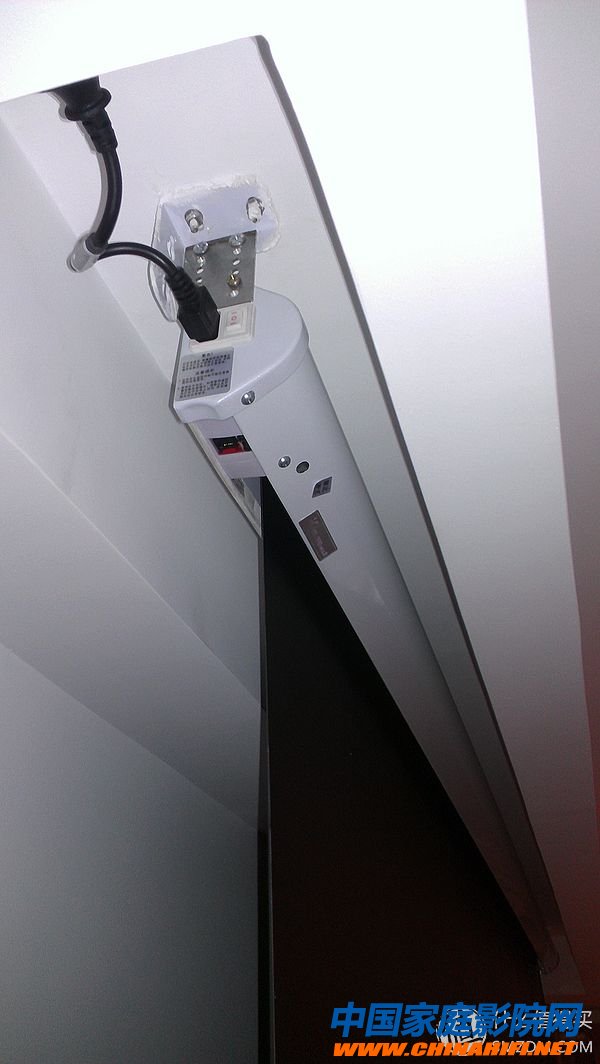
At the same time, an important parameter can be derived here: the distance from the edge of the upper edge of the projection area.
Taking the unreduced installation height as an example, the distance from the top edge of the projection area to the ceiling = 11 cm of the outer casing + 42 cm of the upper black side + the height of the installation is reduced by 0 cm = 52 cm. This parameter is very important and plays an important role in the projection selection and the mounting of the pylon.
Finally, the last piece of my curtain is installed with the finished product (119-inch glass fiber electric screen):
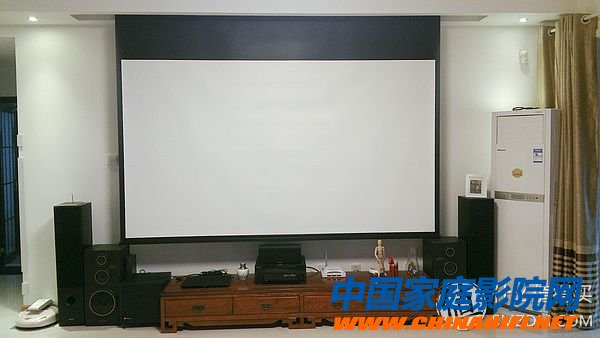
split solar street light is a simplest solar street light which integrated by high efficient PV module, rechargeable battery and LED fitting and smart controller. It offer total freedom from electrical "mains power" without request for trenching cabling or expensive label costing. Not only our solar powered light are clean energy, eco-friendly and ZERO running costs., but also uncontrolled to grid power fluctuations and blackouts, ensuring perfect performance and continuity of service & safety all year round.
Solar Street Light Led,Split Solar Street Lights,Solar Powered Street Lamp,Solar Street Light With Panel
Jiangmen Biaosheng Solar Energy Technology Co., Ltd. , https://www.bsprosolar.com